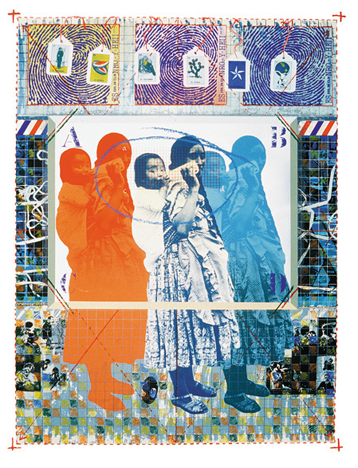ROMEO GALDáMEZ
PEOPLEText: Erika Saca
You’ve produced part of your work in Mexico and Brazil for years. How did your time abroad influence your work?
The theme has always been the same, but the process has been changing. The experience in Brazil was very interesting.
El Salvador fits 200 times in Mexico and Mexico fits 4 times in Brazil. That means that I jumped to a country in which mine would fit 800 times. That also influenced my perception of things; it made me more open, more cosmopolitan. Mexico was a good platform because it has a tradition of graphics; they have a historic notion of the arts. Art is one of the prime sources of tourism.
My work with the United States and Canada gave me a notion of the discipline, ecological and humanitarian conscience.
I returned to El Salvador conscious that I’m here and in the world. Contrary to most immigrants that leave the country every day, I was coming back, knowing that I can produce work from El Salvador for the whole world.

Romeo Galdámez “Sensacional…con(cierto) collage de corazón y la global collection.” (2002)
How did you find your country upon your return?
Mine was a very restless generation. The work that was rejected back in the day, has now been legitimized. I came back and now my work is current and accepted…I’m 52 and my work is young, being exhibited in a center for contemporary art.
I feel like our young artists still need to grow and mature their content in order to find their own language. Although we’re in a globalized world, we need to have a face and a name to stand out. El Salvador has many strong phenomenons that need to be approached in a mature manner, no matter how experimental the form is, themes such as immigration have to be covered.

Romeo Galdámez “Momentum” (2008)
That’s why I took the time to talk about our cultural transformation in this exhibit, the influence of English in our lives and how badly we read it, which is another cultural form.
How would you describe the Latin and Salvadoran identities?
That’s a complex question. First of all we have many identities. Even Salvadorans have many identities. We still don’t have a face, it’s a process. We’re under the American influence and that will result in something.
Before World War II, our influence was European, after that, the United States began to exert hegemony on the rest of the world. My generation was rebellious in that sense; we didn’t like to be given a number. New generations don’t have that conflict; they want to be a number to feel secure at work, at school. This will have a deep impact on our identity as well. We don’t exist as a pure Latin America. I would dare to say that we’re not consolidated as a culture, so we are fragile to adopt new conducts.

Romeo Galdámez “Reflecciones de identidad” (1992)
Where is your work heading?
I’m currently in a new process. I’m starting a series of object-art. I want to continue to talk about people, now more focused on their territory, in a very worldly code.

Romeo Galdámez “Memorias Unidas (Páginas en Construcción)” (2003)
Where do you think Latin American art is heading?
I think that as part of globalization, it’s only natural that Latin American art has a more global form. Traditional painters will continue to make an ode to their hometown. These will remain folkloric souvenirs. But the new trends are becoming more common ground with the rest of the world. Latin American art is no longer the romantic stereotype; it’s become more unified with the languages used in the rest of the world. But there are also deeper areas in Latin America, where there is no access to Internet or electricity. It’s a paradox that there are still some people here that have never been to the ocean, and when someone doesn’t know the ocean, they don’t know that there’s so much more on the other side. It’s a huge contradiction. So the issue comes when we have to learn to coexist and respect our diversities.
El Salvador and Latin America are diverse, so we should try to unite the fragments, icons and pieces of each identity to try to understand our world and to coexist in peace.
Text: Erika Saca
Photos: Courtesy of CCESV © Romeo Galdámez





